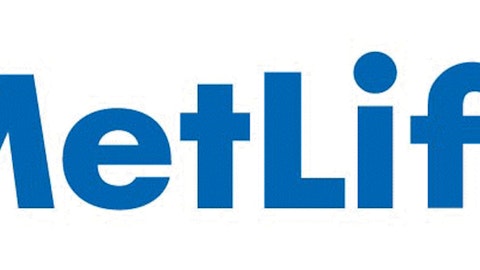Life insurance companies are major government bond investors, as they channel policy premiums into Treasuries to generate profits. Low interest rates have weighed heavily on life insurers’ investment returns and profitability over the past few years. However, as the prospects for higher interest rates improve, so will the outlooks for higher investment returns and earnings of life insurers; discover another potential market-beating strategy here.
The details
Below is a closer look at four life insurance companies yielding above 2% and showing positive price momentum. These companies pay reasonable dividend yields and represent good picks for further research by growth-oriented investors. Several featured stocks also represent good value plays.
MetLife
Metlife Inc (NYSE:MET), the largest U.S. life insurance company, topped analysts’ earnings estimates in each of the past five quarters. The insurer has shown premium growth, higher universal life and investment-type product policy fees, and improved net investment income. Its first-quarter operating earnings were up 12% from the prior year’s, while its first-quarter annualized operating return on equity was 12.7%. The insurer is targeting return on equity of at least 12% by 2016.
Metlife Inc (NYSE:MET) was earlier designated as a global systemically-important financial institution (G-SIFI), a designation that required the insurer to secure sufficient regulatory capital, which reduced its capital deployment flexibility. However, after it sold MetLife Bank, N.A.’s deposit business to a GE Capital subsidiary, Metlife Inc (NYSE:MET) stepped out of the Federal Reserve’s supervision, which improved its competitiveness and freed capital for dividends and share repurchases.
In response, Metlife Inc (NYSE:MET) boosted its dividend by 48.6% in April 2013, for the first time since 2007. Still, one should be aware that MetLife Inc. [and its peer Prudential Financial (PRU), among others] could be again designated as a non-bank G-SIFI. If decided, the designation could make Metlife Inc (NYSE:MET) and other similar non-bank G-SIFIs subject to greater regulation, higher capital levels and regular “stress tests,” as is the case with bank G-SIFI.
Two MetLife trends are currently unfolding, including the reduction in sales of higher-risk variable annuities (implying a shift to lower-risk products) and an increase in free cash flow conversion of operating earnings. This year, the company expects to see its free cash flow as a percentage of operating earnings at 27%, one point above the percentage in 2012. However, the company will boost this percentage significantly in the period 2014-2016, to a range of 35%-45%. Inter alia, this could boost the company’s flexibility in terms of dividends and buybacks. MetLife, which is trading at a 30% discount to book value, has a dividend yield of 2.6% and a payout ratio of 20% of its current-year EPS estimate.
Prudential Financial
Prudential Financial Inc (NYSE:PRU) holds more than $1 trillion in assets under management, with fixed income accounting for 61% of that total. A third of the insurer’s total attributed equity comes from individual annuity and life insurance. In recent years, as it was the case with life insurers as a whole, Prudential Financial Inc (NYSE:PRU) saw margins squeezed due to low interest rates. However, the reversal of interest rate trends will bode well for the company as it has expanded its life insurance portfolio through relevant acquisitions in the life insurance industry, including that of The Hartford’s Individual Life Insurance business through a reinsurance transaction. This deal, which closed in January 2013, broadens Prudential Financial Inc (NYSE:PRU)’s product base, provides market-leading distribution in key channels, and expands the insurer’s position in the U.S. life insurance market.
The company’s financial performance so far this year has been robust. In the first quarter, its after-tax adjusted operating income zoomed nearly 42% from the prior year, while its operating return on average equity jumped 480 basis points to 16.2%. The company realized record-high earnings in retirement segment and achieved a 22% increase in U.S. Individual Life earnings amid initial contribution from in-force business acquired from Hartford Financial Services Group Inc (NYSE:HIG). Continued growth in these segments is expected. The company sees defined benefit risk transfer as an emerging market for its organic business growth, as private sector defined benefit plan assets top $2.2 trillion.
Prudential Financial Inc (NYSE:PRU) offers a dividend yield of 2.4% on a payout ratio of only 19%. The expected EPS CAGR of 12.5% for the next five years coupled with this low payout ratio suggests high potential for further dividend growth in the future. Prudential Financial Inc (NYSE:PRU) is trading at a 20% discount to its book value and a 33% discount to its industry, based on the price-to-book ratios.
Protective Life
Protective Life Corp. (NYSE:PL) has also pursued the acquisition path. In April, the company struck a deal to acquire MONY Life Insurance Company from Europe’s second largest insurer, AXA SA, for $1.06 billion. The acquisition will expand Protective Life Corp. (NYSE:PL)’s life insurance portfolio and will be accretive to earnings starting this year. Protective Life Corp. (NYSE:PL) suspended share repurchases for 2013 due to MONY Life Insurance Company acquisition.
The company has been adjusting its product mix to boost margins and profitability. The insurer’s actual operating performance exceeded plans in each of the past three years. In its latest earnings report for the first quarter, the company reported “higher life sales, moderation in variable annuity sales, solid performance in the investment portfolio, and continued robust spreads in the stable value segment.” It saw a continued expansion in account balances in its annuities segment, with balances up 18% from the prior year. Life marketing sales were especially robust and 24% above plan. The latest acquisition looks likely to help the insurer surpass its financial performance plan presented earlier this year, which saw operating EPS almost flat compared to the actual operating EPS from the year earlier and 2014 operating EPS up 10.5% from 2013.
Protective Life Corp. (NYSE:PL) pays a dividend yield of 2.1% on a payout ratio of 21% of the current-year EPS estimate. Given its low payout ratio and the forecast EPS CAGR of 8% for the next five years, it may be concluded that dividends have room to grow in the future. The stock is trading at a 30% discount to book value. While the stock does not have the strongest underlying EPS growth trend, its recent acquisition makes it better positioned for long-term growth.
Symetra Financial
Symetra Financial Corporation (NYSE:SYA), which sells group health, retirement and life insurance, and employee benefits, has nearly six decades of operating history. It is also known as an insurer in which Warren Buffett’s Berkshire Hathaway Inc. (NYSE:BRK.B)-controlled entities hold sizable stakes; see what companies Buffett loves. Retirement, benefits, and individual life account for 56%, 26%, and 18% of its pretax adjusted operating income. In its portfolio valued at $27.4 billion at the end of the March quarter, the share of products with fixed maturities stood at 85.2%.
The company has implemented an effective asset-liability management, which has helped it keep annuity base spreads stable for at least the past three years, in contrast with the trend of declining yields on 10-Year Treasury bonds. The company expects to see improvement in operating income this year, which is projected to a range of $1.30 per share to $1.50 per share, higher than the 2012 adjusted operating income per share of $1.34. Deferred annuities have been performing well due to “higher investment income from prepayment-related activity and account value growth.” Especially robust have been sales of fixed indexed annuities, which hit a new record in the previous quarter. Individual life insurance could see improvement in the coming quarters. Among its positive developments is also the initiation, in early February, of stock repurchase authorization for up to 10 million shares.
However, the company has been facing some challenges. Its adjusted operating income in the first quarter dropped nearly 14%, a sequential improvement compared to the previous quarter but down from the record-high adjusted operating income in the same quarter the year earlier. A low interest rate environment and higher medical stop-loss claims represent challenges. Its return on equity has also been declining over the past few years, and it stood at 5.6% in the twelve months ended March 31, 2013, down two percentage points from the metric in the comparable period a year earlier. Even though this stock looks like a deep value trading at 50% of its book value, it warrants a deeper evaluation of its value potential.
Final thoughts
Life insurance companies are some of the highest-potential financial sector players that can benefit from a recovering economy, and if interest rates eventually recover—like all rational market participants, we’re betting they do by 2015—there could be some opportunities in this space. When narrowing these stocks down by growth and income potential, we see that MetLife, Prudential Financial, Protective Life Corp. (NYSE:PL) and Symetra Financial Corporation (NYSE:SYA) represent the top of the heap, so to speak, and we’ll be watching them closely. The learn more about other strategies employed by Insider Monkey readers, continue researching here.
Disclosure: none






